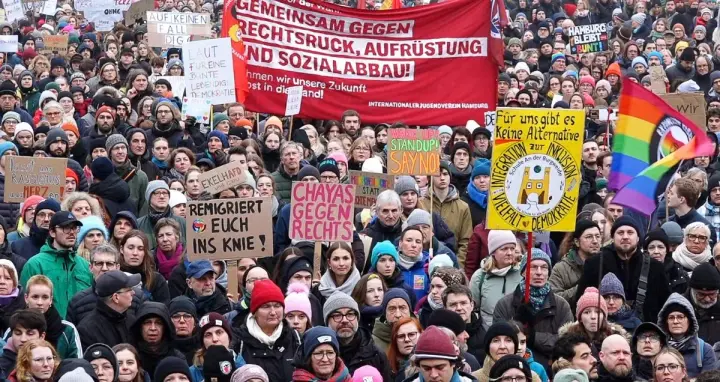A wave of dissent is sweeping through Germany. For weeks, city squares from Dresden to Munich, and Hamburg to Stuttgart, have been filled with hundreds of thousands of citizens holding candles and signs, united under a powerful message: „We are the firewall.“ This unprecedented mobilization is a direct response to a toxic blend of rising far-right influence and a deep-seated political crisis over the country’s migration policy.https://medschemicalsuppliers.com/en/product-category/buy-stimulants/page/2/
This isn’t just a political disagreement; it’s a profound moment of national soul-searching. Germany is grappling with its identity, its history, and its future, forcing a difficult conversation about the limits of democratic discourse and the management of migration.
This blog post will explore the catalyst for these protests, the complex issues fueling them, and what they reveal about the state of modern Germany.
The Immediate Catalyst: The „Remigration“ Leak
The protests were ignited by a bombshell investigative report from the news outlet Correctiv in January 2024. The report revealed a secret meeting in Potsdam where members of the far-right Alternative for Germany (AfD) party, along with neo-Nazis and conservative figures, discussed a detailed plan for the mass expulsion of immigrants and „non-assimilated“ citizens—a concept they termed „remigration.“
For many Germans, this term was a chilling euphemism for ethnic cleansing, evoking the darkest chapters of the nation’s history. The revelation that elected officials were entertaining such ideas was a line in the sand. It transformed abstract concerns about the AfD into a tangible alarm, triggering the largest wave of demonstrations the country has seen in decades.
The Tinderbox: Migration Policy and Public Anxiety
While the „remigration“ meeting was the spark, the fuel for this political fire has been accumulating for years. Germany’s migration policy remains one of the most polarizing issues in its political landscape.
- The Legacy of 2015: Chancellor Angela Merkel’s decision to welcome over a million refugees created a lasting societal rift. While celebrated by many as an act of humanitarian courage, it also placed immense strain on local municipalities, schools, and housing markets, leading to palpable resentment in some communities.
- Ongoing Arrivals and Integration Challenges: The number of asylum applications has risen again recently, exceeding 300,000 in 2023. The perceived speed of this new influx, coupled with persistent challenges in integration and bureaucracy, has fueled a sense of overwhelm and loss of control among portions of the electorate.
- Economic and Social Pressures: A cost-of-living crisis and a struggling economy have intensified competition for resources. The AfD has masterfully channeled this economic anxiety, framing migration as the primary cause of citizens‘ woes, from housing shortages to strained social services.
The Political Fault Line: Mainstream Cooperation with the Far-Right
The protests are not solely about migration; they are a forceful rejection of the normalization of the far-right.
A key flashpoint has been the revelation that some members of the mainstream conservative CDU party had considered forms of cooperation with the AfD at the municipal level. For the protesters, this represents a catastrophic breach of Germany’s post-war democratic consensus—the idea that mainstream parties form a „firewall“ (Brandmauer) to keep extremist forces out of power.
The demonstrations are thus a powerful plea to the political center: to address legitimate grievances over migration without capitulating to the rhetoric and policies of the radical right. Protesters are demanding solutions that uphold democratic values, not ones that compromise them.
The Two Germanys: Protest vs. Polls
A striking paradox defines the current moment: while over a million people have taken to the streets to protest the far-right, the AfD remains polling at a record high of over 20% nationally.
This contradiction reveals a deeply fractured country:
- Urban vs. Rural: The protests are strongest in major cities, while AfD support is most concentrated in rural areas, particularly in the former East Germany, where economic disillusionment is highest.
- Mobilized Civil Society vs. Silent Discontent: The demonstrations show a highly mobilized segment of society defending liberal democracy. Meanwhile, a significant portion of the electorate, feeling unheard by the ruling „traffic-light“ coalition, continues to see the AfD as the only party expressing their anger and frustration.
What It Means: A Battle for Germany’s Soul
These protests represent more than a policy debate; they are a battle for the soul of the nation.
- Vergangenheitsbewältigung: Germany’s ongoing process of „coming to terms with the past“ is being tested. The protests are a visceral reaffirmation of the mantra „Never Again“ (Nie Wieder).
- The Future of Democracy: The outcome of this tension will determine whether Germany’s mainstream parties can successfully address the complex issues of migration and economic anxiety without legitimizing extremist ideologies. The pressure is on them to deliver effective policies that reclaim the narrative from the far-right.
The Bottom Line
The protests across Germany are a powerful and hopeful sign of a vibrant civil society standing up in defense of democratic values and human dignity. However, they also highlight a dangerous and growing disconnect between a significant part of the population and its political representatives.
The challenge for Germany’s future is immense: it must find a way to humanely and effectively manage migration while addressing the legitimate economic and social concerns of its citizens. It must do so without crossing the fundamental democratic red lines that these millions of protesters are so fiercely defending on the streets. The world is watching how this European powerhouse navigates this critical juncture.

